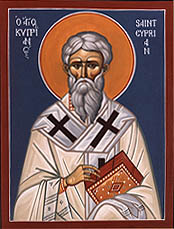Archdiocese of Carthage
The temporal importance of the city of Carthage in the Roman Empire had previously been restored by Julius Caesar and Augustus.In Christian traditions, some accounts give as the first bishop of Carthage Crescens, ordained by Saint Peter, or Speratus, one of the Scillitan Martyrs.[9][12][13][14][15] In the 3rd century, at the time of Cyprian, the bishops of Carthage exercised a real though not formalized primacy in the Early African Church.[16] Cyprian faced opposition within his own diocese over the question of the proper treatment of the lapsi who had fallen away from the Christian faith under persecution.The Donatists stressed the holiness of the church and refused to accept the authority to administer the sacraments of those who had surrendered the scriptures when they were forbidden under the Emperor Diocletian.The Donatists also opposed the involvement of Emperor Constantine in church affairs in contrast to the majority of Christians who welcomed official imperial recognition.The most articulate North African critic of the Donatist position, which came to be called a heresy, was Augustine, bishop of Hippo Regius.Although the dispute was resolved by a decision of an imperial commission in the Council of Carthage (411),[9] Donatist communities continued to exist as late as the 6th century.Unable for that reason to attend the Council of Ephesus in 431 as chief bishop of Africa, he sent his deacon Basula or Bessula to represent him.Saint Eugenius was consecrated in around 481, exiled, along with other Catholic bishops, by Huneric in 484, recalled in 487, but in 491 forced to flee to Albi in Gaul, where he died.[18] They were written in reply to consultations regarding a conflict between the bishops of Carthage and Gummi about who was to be considered the metropolitan, with the right to convoke a synod.In the letter addressed to Petrus and Ioannes, Pope Leo adds to his declaration of the position of the bishop of Carthage the eloquent[20] declaration: "... nor can he, for the benefit of any bishop in the whole of Africa lose the privilege received once for all from the holy Roman and apostolic see, but he will hold it until the end of the world as long as the name of our Lord Jesus Christ is invoked there, whether Carthage lie desolate or whether it some day rise glorious again".[21] When in the 19th century the residential see of Carthage was for a while restored, Cardinal Charles-Martial-Allemand Lavigerie had these words inscribed in letters of gold beneath the dome of his great cathedral.[25] Some primary accounts including Arabic ones in 10th century mention persecutions of the Church and measures undertaken by Muslim rulers to suppress it.The equivalent contemporary entity for the historical geography in continuous operation would be the Roman Catholic Archdiocese of Tunis, established in 1884.




Roman Catholic Archdiocese of TunisCarthageCyriacus of CarthageAgostino CasaroliRoman EmpireVandal KingdomByzantine EmpireUmayyad CaliphateAbbasid CaliphateFatimid CaliphateFrench protectorate of TunisiaTunisiaEcclesiastical provinceEarly African churchCoordinatesCatholic ChurchSui iurisLatin ChurchAfrican Rite2nd centuryIn partibus infideliumFrancisTitular archbishopLatin CatholicdioceseAgrippinJulius CaesarAugustusRoman provinceAfrica ProconsulareprimacyarchdioceseRoman AfricaNorthern AfricapatriarchPope Leo IRoman BishopChurch of RomeCatholic Church in ItalyWestern liturgical ritesLatin languageRoman RiteSaint Perpetua, Saint Felicitas, and their CompanionsTertullianCyprianCaecilianusSaint AureliusEugenius of CarthageBerbertrinitarian theologyLatin Christianitycouncils of CarthageDonatismArianismManichaeismPelagianismMuslim conquest of the MaghrebBattle of Carthage (698)persecutionCatholic titular seeCyprian of CarthageChurch FatherCrescensSaint PeterScillitan MartyrsEpenetus of CarthagePseudo-DorotheusPseudo-Hippolytusseventy disciplesSaint PerpetuaThuburbo MinusAgrippinusSaint Perpetua and Saint FelicitasBasilica of Damous El KaritaProconsular AfricaByzacenaTripolitaniametropolitanNumidiaMauretaniaCouncil of Carthage (256)DonatistDiocletianEmperor ConstantineAugustineHippo RegiusCouncil of Carthage (411)MensuriusFirst Council of NicaeaPope Julius IDonatus MagnusCouncil of SardicaCouncil of Carthage (349)PrimianusParmenianusMaximianCouncil of EphesusQuodvultdeusGaisericNaplesSaint DeogratiasSaint EugeniusHunericCouncil in 525Eastern Roman Empirepraetorian prefecture of AfricaVandalic WarThree Chapters ControversyPontusSecond Council of ConstantinoplePope Gregory the GreatPope Theodore IPatriarch Paul II of ConstantinoplePope Leo IXPatrologia LatinaAfricaCharles-Martial-Allemand LavigeriePope Gregory VIIlocal LatinIslamizationbishopricsMaghrebPope FormosusBenedict VIIarchbishopLeo IX